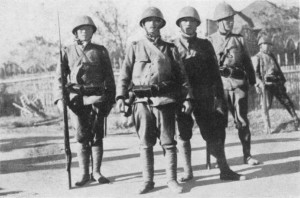64 Seconds in Hell
- By Peter Harmsen
- 20 March, 2013
- 9 Comments
 What was it like to be a Chinese or Japanese soldier fighting for one’s life in and around Shanghai in the fall of 1937? No one who wasn’t actually there to go through that horrific experience will ever really be able to tell. Seventy-six years on, all we can do is look at the sources at our disposal and try to use our imagination.
What was it like to be a Chinese or Japanese soldier fighting for one’s life in and around Shanghai in the fall of 1937? No one who wasn’t actually there to go through that horrific experience will ever really be able to tell. Seventy-six years on, all we can do is look at the sources at our disposal and try to use our imagination.
As sources go, authentic footage may be the best available option if one wishes to visualize the distant past. It does a much better job than photos, let alone written sources, in getting across the general feel of an event that has long since passed into history. It’s interesting to consider how much more we would know about the Sino-Japanese War, and about World War II in general, if every soldier had been equipped with a smartphone.
In this clip, the Battle of Shanghai from August to November 1937 takes up the segment between 1:10 to 2:14. (The first part is about the fighting in north China beginning in July 1937, including a quick glimpse of an obviously very primitive field hospital between 0:59 and 1:06.) It’s just 64 seconds, obviously shot from a Japanese perspective, but they are brimming with information.
The tank that rolls past between 1:10 and 1:12 has an anchor painted in front, showing it is from the Special Naval Landing Force, the Japanese marine units that almost got pushed out of Shanghai in the early stages of the fighting in August. Japan’s technological superiority, especially in the air and in terms of artillery, both land-based and naval, is on display between 1:17 and 1:39. 1:40 to 1:47 shows Chinese refugees, including large numbers of uprooted people crowding the Bund, Shanghai’s famous waterfront.
The rest is about Japan’s victory in Shanghai. 1:50 to 2:04 depicts that event the way Japan wanted to show it to the public at home. Japanese cavalry parades down a Shanghai boulevard, as onlookers, most likely members of Shanghai’s Japanese community, wave small flags. The subsequent footage, 2:05 to 2:14, of Chinese civilians, is probably closer to the truth. The worried expressions on their faces reflect the deep apprehension as the city began what was to become eight years of occupation.
The rest deals mostly with the conquest of Nanjing. As is to be expected in propaganda footage, nothing even hints at the senseless massacre of prisoners and civilians which took place after the fall of that city.

 Copyright © 2025
Copyright © 2025
Leave a Reply